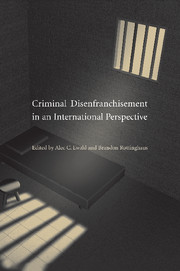Book contents
- Frontmatter
- Contents
- Contributors
- Foreword: Waves of Democracy and Criminal Disenfranchisement
- Acknowledgments
- Introduction
- Part I CONTEMPORARY DISENFRANCHISEMENT LAW
- Part II DISENFRANCHISEMENT IN COMPARATIVE PERSPECTIVE: LEGAL AND POLITICAL APPROACHES
- 3 U.S. Felon Disenfranchisement: Parting Ways with Western Europe
- 4 The Right to Universal, Equal, and Nondiscriminatory Suffrage as a Norm of Customary International Law: Protecting the Prisoner's Right to Vote
- 5 Our ‘Crooked Timber’: Why Is American Punishment So Harsh?
- Part III VOTING RIGHTS AND PEOPLE WITH CRIMINAL CONVICTIONS: CASE STUDIES
- Index
- References
5 - Our ‘Crooked Timber’: Why Is American Punishment So Harsh?
Published online by Cambridge University Press: 03 July 2009
- Frontmatter
- Contents
- Contributors
- Foreword: Waves of Democracy and Criminal Disenfranchisement
- Acknowledgments
- Introduction
- Part I CONTEMPORARY DISENFRANCHISEMENT LAW
- Part II DISENFRANCHISEMENT IN COMPARATIVE PERSPECTIVE: LEGAL AND POLITICAL APPROACHES
- 3 U.S. Felon Disenfranchisement: Parting Ways with Western Europe
- 4 The Right to Universal, Equal, and Nondiscriminatory Suffrage as a Norm of Customary International Law: Protecting the Prisoner's Right to Vote
- 5 Our ‘Crooked Timber’: Why Is American Punishment So Harsh?
- Part III VOTING RIGHTS AND PEOPLE WITH CRIMINAL CONVICTIONS: CASE STUDIES
- Index
- References
Summary
“Out of the crooked timber of humanity, no straight thing was ever made.”
Emmanuel KantINTRODUCTION
During the last few years, while writing on the disenfranchisement of ex-felons, I often wondered why, almost alone among Western democracies, we in the United States treated people “who had paid their dues” with such contempt. Almost every other democratic nation restores full voting rights to all ex-felons, and a considerable number, including Canada and 17 European countries, now extend the franchise even to offenders behind bars. Several countries consider the franchise so important that they actively encourage inmates to participate in the electoral process. Yet all but 2 of the 50 U.S. states deny prisoners the vote, and most bar probationers, parolees, and other nonincarcerated people from voting, either indefinitely or during a waiting period. Even for those eligible, restoration can include not only complicated bureaucratic procedures but also, until recently, DNA testing. Several states effectively bar some convicts from voting for life, treating them as debtors forever – a policy that “verges on the macabre.” Despite reforms to some American ex-felon disenfranchisement policies in recent years, laws barring all inmates from voting remain relatively popular in the United States – not only among the public, but also among leading Democratic politicians.
In my opinion, the simplest way to explain why almost all U.S.
- Type
- Chapter
- Information
- Criminal Disenfranchisement in an International Perspective , pp. 136 - 164Publisher: Cambridge University PressPrint publication year: 2009

